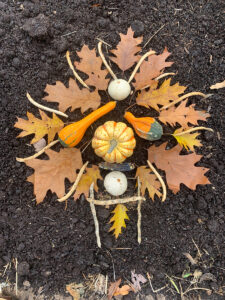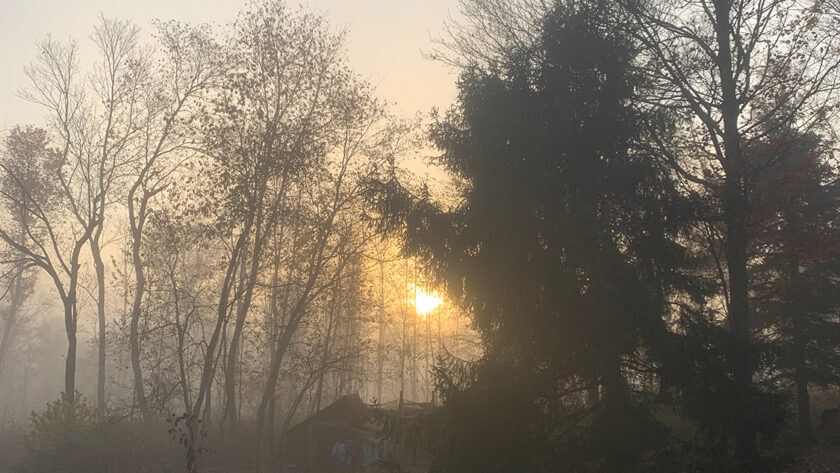In permauclture design, the “observe and interact” principle is the very first thing we do. This principle asks a practitioner to spend considerable time (up to a year) observing and interacting with a site. This would include regular observations in different seasons, different times of day, and keeping notes. You would likely also do soil tests, measure wind and rain, use a solar pathfinder and also your eyes to understand the path the sun takes, and find out as much as you can about the conditions of the site. You would log information on what wildlife is present, any that are endangered or need specific habitat, and more. Through this process, you learn about the wind, light, rain, soil, potential pollution, resources available, and existing flora and fauna, and thus, understand the site’s strengths, challenges, existing biodiversity, resources, and more. This allows you to create a plan that is intertwined with the living earth and that is thoughtful and robust.
When you start learning permaculture, this principle is really stressed–without a very clear idea of what is happening on the site already, it is hard to work with nature to create the best design possible. Thus, this principle is a really critical one for all of the rest to follow. This principle also happens to be a major part of how we can enact animistic permaculture.
In last week’s post, we covered an introduction to animistic permauclture practice, the synthesis of an ecologically-baed design system, and the belief in spirits to develop a richer practice. Specifically, we examined the ethics of this system, and added the “spirit aware” ethics to earth care, people care, and fair share. In today’s post, we are going to explore the first permaculture principle, “observe and interact”, which lends itsself particularly well to the practice of animistic permaculture.
Observe and Interact: Connecting to the Genius Loci, the Spirit of Place

There are lots of reasons to engage in observation and interaction in the land around you–and many reasons you may want to take it a step further. In permaculture practice (as i mentioned above), you can observe the land over a period of time to best understand how to work with nature. B ut perhaps you’ve lived somewhere for a while, and you want to build a deeper connection by simply inhabiting the space and being present. I offered some suggestions on observing nature more closely in this post.
Inaddition to observing the physical landscape through your five senses, you can also attend to observing and interacting with the spirits of the land. The spirits might include the Genius Loci, the spirit of place, as well as individual spirits who may be present through plants, animals, stone, soil, and more. Thus, you attend just as deeply to the spirit as you do matter., observing, interacting, and listening to the voices of the spirits of the land. This can lead to some very deep insights not only about the land itself but better ideas from spirits about how things would work best (e.g. what to plant, where to plant, things you need to know that you may not get through observation).
The Genius Loci is a term that came from pagan Rome in antiquity–the Romans recognized that all of the living beings, objects, activities, structures, and so on created a larger spirit of place. This spirit was protective in nature and served, in part, to help protect and guide an area. This term is used widely in the druid tradition today in a fairly similar way: we druids recognize that places have Geni Loci and those spirits should be acknowledged, honored, and their wishes heard and respected. We also recognize that if we want to get permission from a place, it is the Genius Loci that serves as the representative of that larger landscape.
Before you want to make any kind of change to a landscape (putting in a garden, building a new house, adding a new compost pile, building a sacred circle), it is very important to connect with the Genius Loci to honor, listen, and communicate, and eventually to co-create intentions with nature.
Connecting with the Genius Loci
1. Find a place that represents the Genius Loci. To begin to connect with, honor, and communicate with the Genius Loci, as part of your observations and interactions, find what you would consider being a center point or important feature of the land. You will sense that this place is important and special in some way. You may be drawn to it intuitively. Or, you might find some large or prominent feature of the land. In both of my experiences on my own property, these have been large trees. On my first homestead in Michigan, a huge white pine in the center of the property was where I communed with the Genus Loci. On the current Druid’s Garden homestead, we have one Oak tree that is several hundred years old and about twice as large as any other tree–this tree makes you take notice and definitely holds the energy of the surrounding space. In another place, they may have been a large stone, waterfall in a stream, cave, or some other prominent feature.
If this is not immediately apparent, take time to find this place. You might speak your intentions or share your intentions aloud–ask the place to lead you to where to connect with the genius loci. Now–technically–you can connect with the spirits of place everywhere. But I have found taking this initial step is really useful for reasons that will become apparent as we work through these steps.
2. Build initial trust and connection with the Genius Loci. At this point, take time to be present and available. Show that you have good intentions by making offerings and taking time to be present in that space. When you feel led, speak aloud, saying that you would like to meet the Genius Loci and connect with the spirit of place. Use inner and outer spirit communication skills to listen carefully to what the Genius Loci says. Take time for this–sometimes the first few times you meet often simply a “hello” and being present with each other.

Often, you may be asked to do something. You might be asked to leave and return at a later date. You may be asked to do certain things(e.g. clean up the burn piles and garbage before we speak again). These initial things you may be asked to do are ways for you to establish trust and allows the spirits of place to see what kind of human you are. Do you listen? Do you engage respectfully? Do you honor the sovereignty of the spirits of the land?
3. Establish some kind of regular interaction with the Genius Loci. In order to continue to build your relationship with the Genius Loci, you will want to establish some kind of regular interaction with them. You can build this into your regular seasonal cycles and/or holidays, or you can build it into some other regular practice. One of the things I like to do is create a shrine with their input. This can be a nice flower bed that you tend well, a small altar where you leave offerings, etc. Build this into your design for the site, and tend it regularly.
Part of the reason you do this is to build this relationship and make sure that the spirits of the land are equal partners in the development of your permaculture design. But the other reason is that the Genius Loci is a very good source of information–you can visit the spirit and learn about what potential problems may be popping up, how to solve certain problems, or they can offer you other teachings and advice. This regular interaction allows you to have your finger on the pulse of the spiritual heartbeat of the land.
Co-Setting Intentions and Agreements with Nature
While traditional permaculture design takes nature into consideration, in that we work to build regenerative, resilient systems that work with nature rather than against nature, an animistic permaculture philosophy takes this relationship quite a bit further. Traditional permaculture design works with nature, but does not necessarily view nature as a sovereign being who also should have a voice decision-making process. This is because mainstream permaculture does not recognize the spirit in all things nor does it have ways of hearing the voices of nature. But in practicing animistic permaculture, we need to work with nature both physically and in spirit to create and enact a design.

As part of the process of observation and interaction, you will have already connected with the Genius Loci (spirit of place) as well as a variety of other spirits of nature. Returning to our animistic philosophies I shared above, we need to engage in respectful interaction with spirits of nature, which includes building right relationships with them, and critically, honoring and recognizing their sovereignty. Thus, as part of any plan, the spirits of nature need to have an equal voice and say. To do this:
1. Establish a clear communication line with the spirits of nature, especially the Genius Loci. The Genius Loci can often speak for the spirits of the land as a whole. You may also need to connect with individual spirits depending on how the design unfolds.
2. Set overall intentions together (e.g. what are your overall goals? How might you work together to meet those goals? What are things you both want to see happen?
3. Collaborate on specific features. Then you can get into the specifics of the design. I have found it more effective to come up with some general ideas rather than a fully-fledged design (e.g. we’d like a big garden, I’m hoping for a sacred grove that is a stone circle somewhere in the woods) than “I want to put a 1000 square foot garden over there”). The Genius Loci may also have some ideas of things that they would like to see–you can share ideas, build collaboratively, and help create a design that works for all. Often the Genius Loci has deep insights into not only the physical aspects of the land but energetic aspects (e.g. right placement of a sacred space based on underlying ley line energy flows).
4. Establish agreements. Another thing you will want to do is establish agreements with the land about ongoing tending. For example, if you have agreed to put the 1000-square foot vegetable garden in a certain location, also discuss that you will need to weed the garden regularly and that plants that grow in the garden that are unwanted may be pulled (used, composted, etc). This helps you establish long-term relationships with the spirits of nature (and doesn’t require that you ask permission to every plant you need to weed).
Usually, this is a negotiation process. What we’ve found on the Druid’s Garden Homestead is that the land gave us access to certain places to tend and build as we wanted, but other places were meant to be left undisturbed and unmanaged. We also make regular offerings each season but we do not need to make an offering or seek permission each time we want to weed or harvest from the garden (we are homesteading, so we grow about 30% of our own food–doing this for each plant or vegetable would be very difficult!). These larger agreements allow you to live in connection and collaboration with the land.
5. Continue regular communication over time. As the design is enacted, continue to connect regularly to “check-in” using #3 above. Checking in can happen on a regular cycle or just whenever you feel like it. For me here, I like to do regular check-ins and leave offerings at each of the major eight holidays of the year–that’s part of the celebration of the holiday and building it in this way makes sure that even when I get busy, I don’t forget to honor my commitments.
For those who are really interested in this co-creating intentions with nature practice, I offer more details in my post “co-creating intentions with nature”.
That wraps up this week’s exploration into the synthesis of animism and druidry–I’m going to share at least one more practice in next week’s post, and probably return to this later as more things emerge that I want to talk about. To my readers: in what ways have you worked to connect with the Genius Loci and/or co-create intentions with nature? I would love to hear some of your stories and insights. Blessings!




Despite my disgust with the Amazon series “Lord of the Rings: Rings of Power” (awful dialogue) there is a line where the Dwarf Princess Disa tells Elrond the Elf about how her people sing to the rock and then the rock sings back, letting them know where and how to dig, and where not to. It’s brilliant! It might explain metallurgists and how jewelers can cut gems and crystals. I shared this post on my Facebook Timeline. Very few people know about the genus loci. The Cure of Ars, a French priest, used to “salute” the “angel” aka guardian for each place he traveled through. It’s too bad the Catholics lost touch with guardian spirits. Our world would have been a much better place had they learned about feng shui and plant spirits and rock spirits.
Cool, I’ll have to check it out! I agree with the loss of connection to the guardian spirits. I actually just came back from the Czech republic, and while there, I was able to visit a mountain and there was a wonderful statue of the local mountain spirit/diety! It had been destroyed by Christians, but later, it was put back up and now you can visit :).
thank you. very insightful and inspiring. gave me some new ideas
RBB
Thank you! 🙂
At first, I meditated to get in touch with the gnomes. They responded to my call and “Warcum” was the name I called the garden gnome who gave me careful instructions on caring for the fruit and nut trees in my yard. Later, I wanted to co-create with the Faerie Realm and my aging mother. We made a working pact, and the Faerie Kin suggested building a tall pole with a circular flowerbed beneath in a particular part of the yard as our communication tower/antenna. We consulted with the Faerie Kin occasionally and listened to their advice as we created driftwood lawn furniture and arbors, added raised beds, and woodburned signs for our “Green Garden of Peace”. Following their guidance, I erected a Faerie Story Attraction Pole/Antenna…and together we wrote our book, “Faerie Wisdom to Live By”. This is how I have worked in connection with a Genius Loci. I continue to co-create intentions with Nature by arranging “Collaboration with Gaia” workshops and retreats. Thank you for your article!
Zing- thank you for sharing! These are awesome examples of connecting with the genius loci of the land. I think its helpful to have healthy agreements in place. Blessings to you on your journey!
Thank you Diana for this thought provoking post.
As a Michigander I hope to meet you someday if your travels bring you back.
My question for you is as In the permaculture circles I fallow, there is often talk of the Wendigo.
Is there a celtic name for the spirit this represents?
Hi Gnomieo, Thanks for your comment and question. The answer is–not that I know of. There are dark spirits, but I don’t know of a specific one that is the equivalent. I am not a specialist in Celtic mythology, so perhaps someone who is a specialist in that area could answer this question.
Thanks for your time